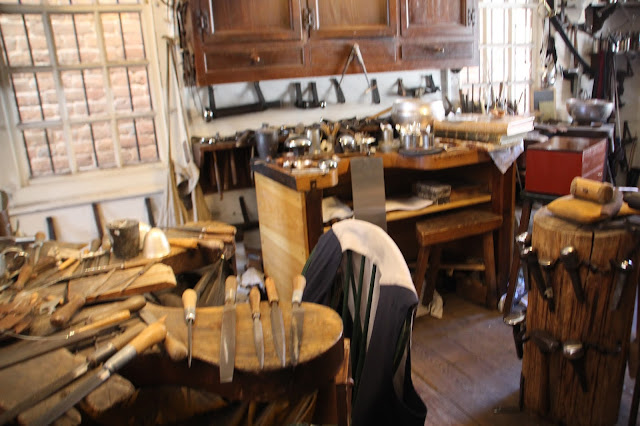Day 1 and 2 Toronto - Johnstown PA - Williamsburg VA
Day 8 Williamsburg
Today we plan to complete our tour of Colonial Williamsburg.
Signs of Halloween were everywhere. even the horses were decorated.
Lots of townspeople out strolling on a gorgeous day.
John, photobombing as usual.
Well, some people had to work.
Inspecting everyone??
In the gardens it was all work.
James Anderson, Blacksmith.
During the early years of the Revolutionary War, Williamsburg blacksmith James Anderson expanded his small, commercial site into a Public Armoury. As Public Armourer, Anderson maintained and manufactured many of the weapons, tools, and other equipment used by the American military.
Tinman Steve Delisle creates cups and kettles, and softer sounds the squeak of shears cutting sheet metal, the tap of a hammer, and the muffled thump of a mallet. As Delisle says: “The din of tin is nowhere near as loud as the blacksmith’s trade.”
WM Pitt's shop.
Fashion in Colonial Virginia was vibrant, fickle, fleeting, fun and something of an obsession for the middle and upper classes. It also was part of the Trans-Atlantic trade between Great Britain and her American colonies.
“Keep in mind that fashion changed as fast as the weather in England and hence in Virginia, therefore what style or philosophy was in vogue one year would be forgotten the next,” said Whitacre who oversees the interpretation at the millinery shop. “It is comforting to know that 18th Century people were concerned about the rapidly changing fashion and the amount of time, energy and money lavished on fashion as we are in this century.”
Halloween decorations.
One of my favourites as I knew nothing about wig making in those days.
.
Today's shop represents Edward Charlton, who practiced the trade for more than a half century and became one of the most important 18th-century wigmakers in Virginia. Many prominent men in Virginia, such as Thomas Jefferson, Patrick Henry and George Wythe frequented his shop.
The first colony to speak for American independence, Virginia spoke with the unanimous voices of the gentlemen who gathered May 15, 1776, in the tall brick building that dominated the east end of Williamsburg. From what had been England's original New World possession, Virginia instructed its delegation at Philadelphia's Continental Congress to move the question of freedom. Thomas Jefferson's Declaration of Independence records the Continental Congress's answer.
The gentlemen at Williamsburg sat in the oldest representative assembly in what was now the world's newest nation. The legislature first met at Williamsburg on April 21, 1704, when the Capitol on Duke of Gloucester Street was still under construction. Literally and figuratively, however, its foundation dated to 1619, when the House of Burgesses first convened at Jamestown.
After fire destroyed (for the third time) the Jamestown Statehouse in 1698, the burgesses decided to move the colony's government to Middle Plantation, soon renamed Williamsburg. On May 18, 1699, they resolved to build the first American structure to which the word "Capitol" was applied.
Henry Cary, a contractor finishing work on the College of William and Mary's Wren Building (the legislature's temporary home) took charge. He raised a two-story H-shaped structure – really two buildings connected by an arcade. Each measured 75 feet by 25 feet; their south ends terminated in semicircular apses penetrated by three large round windows.
Another excellent guide!
The first floor of the west building was for the General Court and the colony's secretary.
The first floor of the east part of the building was for the House of Burgesses and its clerk. Arched windows marched across the facades.
Once a year, a naturalization ceremony is held at the Capitol, during which a new group of immigrants becomes Americans, continuing a process begun in the building nearly 300 years earlier.
And we'll end our trip with a glorious fall photo.














































Jackie, you sure saw some great things.
ReplyDeleteI would definitely enjoy spending time here!
ReplyDelete